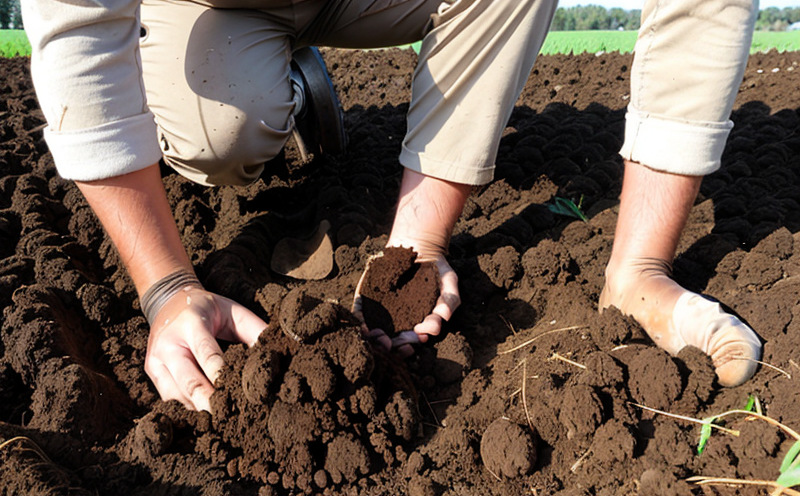Soil Water Holding Capacity Testing
The soil water holding capacity (SWHC) testing is a critical component of agricultural and forestry quality assurance processes. It measures how much water can be held by the soil in its pores, which is vital for understanding the soil's ability to supply water to plants during periods of low rainfall.
Soil structure, texture, and organic matter content all influence SWHC. These factors determine the volume of air spaces within the soil matrix, thereby affecting how much water can be retained. Proper testing ensures that agricultural practices are optimized for both crop yield and sustainability. In forestry, accurate knowledge of SWHC is essential for managing irrigation schedules, ensuring optimal tree growth, and minimizing environmental impacts.
The standard procedure involves collecting representative soil samples from various depths within the root zone where plants obtain nutrients and water. The samples should be air-dried to remove excess moisture before conducting the test. This step ensures that any deviations observed are due to SWHC rather than residual soil moisture content.
SWHC testing typically uses a gravimetric method or a centrifugal force approach, depending on available resources and required precision levels. Both methods aim at determining how much water can be held by the soil after it has been saturated and allowed time for drainage according to specified criteria (ASTM D6451).
Accurate testing results are essential for making informed decisions about irrigation strategies and fertilizer application rates, which directly impact crop health and productivity. Additionally, SWHC data helps in assessing potential risks associated with over-irrigation or drought conditions, thus supporting sustainable land management practices.
A well-executed SWHC test can help identify areas of poor soil quality that may require remediation efforts such as adding organic amendments to improve structure and water retention capabilities. This information is particularly valuable when planning long-term agricultural projects aimed at enhancing overall farm productivity while reducing environmental footprints.
Why It Matters
Understanding SWHC is crucial for optimizing irrigation practices, improving crop yields, and promoting sustainable farming methods. For instance, knowing the exact water-holding capacity allows farmers to adjust their watering schedules more precisely, ensuring that plants receive optimal amounts of moisture without wasting resources.
- Optimized Irrigation: Knowing how much water can be retained by different types of soils enables precise irrigation scheduling, reducing both water usage and associated costs.
- Improved Crop Yields: By matching the amount of water supplied with what the soil can naturally provide, farmers can enhance plant growth leading to higher yields per hectare.
- Sustainable Land Management: Accurate SWHC testing aids in identifying degraded soils that need special attention through organic amendment applications or other remedial measures.
In forestry, accurate SWHC data is instrumental in planning sustainable harvesting practices and preserving natural ecosystems. It helps predict the impact of logging activities on local hydrological cycles, enabling better-informed decisions regarding reforestation efforts post-harvesting operations.
Benefits
- Precise Irrigation Planning: SWHC testing provides valuable insights into soil moisture retention capabilities, allowing for more accurate irrigation scheduling.
- Economic Savings: By minimizing unnecessary watering or overwatering, farmers can save money on water bills and reduce labor costs associated with frequent monitoring activities.
- Better Crop Quality: Consistent access to appropriate amounts of water during critical growth stages enhances fruit quality and nutritional content.
- Sustainability: Understanding SWHC helps promote sustainable farming practices that respect natural resource limits while boosting yields.
In addition, SWHC testing supports broader environmental goals by helping reduce non-point source pollution from runoff. Farmers who understand their soil’s ability to hold water are better equipped to manage nutrients effectively, preventing excess fertilizers from entering nearby waterways.
Use Cases and Application Examples
SWHC testing finds application across various sectors including agriculture, horticulture, landscaping, and forestry. Here are some specific use cases:
- Agricultural Fields: Testing SWHC on different fields allows farmers to tailor irrigation plans based on local soil characteristics.
- Golf Courses: Maintaining optimal SWHC ensures that greens remain lush and healthy, enhancing overall playing conditions.
- Horticulture Nurseries: Consistent SWHC monitoring helps maintain ideal root zone environments for potted plants and cut flowers.
- Forestry Plantations: Accurate SWHC data informs decisions about planting density, fertilization practices, and pest control measures.
For example, a large-scale agricultural operation might use SWHC testing results to implement precision irrigation systems that deliver just enough water where needed. This approach not only conserves resources but also improves crop uniformity across vast tracts of land.





